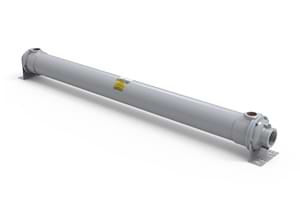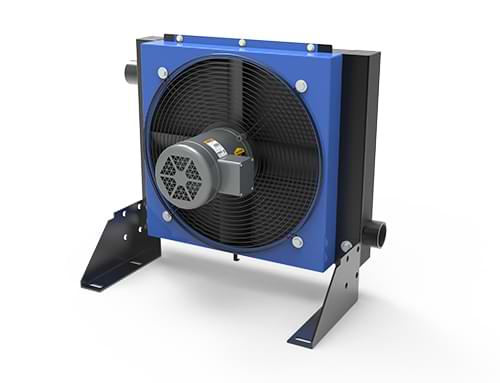Piston Compressor Aftercoolers
Piston compressors, also known as reciprocating compressors in some contexts, rely on a piston-cylinder mechanism to compress air in intermittent cycles. This process generates significant heat and moisture, which can compromise air quality, and equipment durability.
- Cooling Efficiency: Lowers compressed air temp, improving system performance, reliability, and lifespan of components in industrial applications.
- Moisture Removal: Condenses water vapor effectively, preventing corrosion and damage to downstream tools, equipment, and piping systems.
- Energy Savings: Reduces compressor workload significantly, resulting in lower energy consumption and operational costs over time.
Water Cooled Aftercoolers
Compressor Cooling
- Fixed or Removable Tube Bundles
- Material Options Available
- Standard and Custom Options

Air Cooled Aftercoolers
Compressor Cooling
- Use Ambient Air to Cool
- Variety of Motor Options
- Standard Pressures of Up To 250 psi

Aftercoolers mitigate these issues, enhancing the performance of piston compressors in applications like small workshops, automotive repair, and light industrial tasks. Understanding how piston compressors compare to rotary screw and other reciprocating types underscores why aftercoolers are particularly valuable for these systems.
Piston compressors operate by drawing air into a cylinder and compressing it with a reciprocating piston, a process that produces high temperatures—often exceeding 300°F (149°C)—due to the intense friction and pressure changes. This heat causes water vapor to concentrate in the compressed air, which, if uncooled, condenses into liquid as it moves through cooler piping or tools.
An aftercooler steps in by rapidly lowering the air temperature after compression, typically to within 15–25°F of ambient levels. This cooling forces moisture to condense early, and when paired with a moisture separator, removes a significant portion—often 60–70%—of the water content. For piston compressor users, this means reduced corrosion in air lines, fewer clogs in pneumatic tools, and cleaner air for tasks like spray painting or powering air-driven machinery.
Compared to rotary screw compressors, piston compressors are less suited for continuous operation. Rotary screw designs use twin screws to compress air smoothly and consistently, making them ideal for heavy-duty, non-stop industrial use. Piston compressors, by contrast, excel in shorter, intermittent cycles, offering a lower upfront cost and simpler maintenance for smaller-scale needs.
However, their stop-start nature amplifies heat spikes, making aftercoolers even more critical than in rotary screw systems, where heat is more evenly distributed. Within the reciprocating family, “piston compressor” and “reciprocating compressor” are often interchangeable terms, though “reciprocating” can also refer to larger, multi-stage industrial units. For single-stage or two-stage piston compressors common in garages or small factories, aftercoolers remain equally beneficial.


